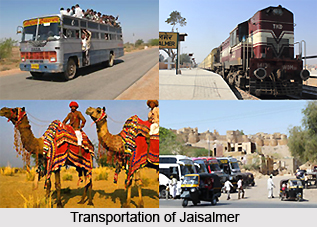 Jaisalmer is an important locale, which has drawn the attention of myriads of tourists and visitors from far off places. Tourists of foreign countries pay visit to this place with lots of enthusiasm and vigor. Due to its popularity as an ideal tourist destination it has established its links not only with Rajasthan as well as the rest of Indian subcontinent. For instance New Delhi lies 864 km, while Jaipur is situated at a distance of 558 km. Also Mumbai and Ahmedabad lie 1177 km and 626 km respectively.
Jaisalmer is an important locale, which has drawn the attention of myriads of tourists and visitors from far off places. Tourists of foreign countries pay visit to this place with lots of enthusiasm and vigor. Due to its popularity as an ideal tourist destination it has established its links not only with Rajasthan as well as the rest of Indian subcontinent. For instance New Delhi lies 864 km, while Jaipur is situated at a distance of 558 km. Also Mumbai and Ahmedabad lie 1177 km and 626 km respectively.
Airport also is an integral part of the transportation of Jaisalmer. It meets the increasing needs of the people. Although Jaisalmer does not have direct connectivity with airways as a whole, Jodhpur airport lies at a distance of three kms away. From Jodhpur one can hire taxis to various places including Jaisalmer. Transportation of Jaisalmer constitutes of railways. In fact Jaisalmer is well connected with main cities of Indian subcontinent via broad gauge and also meter gauge railway tracts.
One can even avail trains directly to places like Jodhpur and Delhi. Direct trains from Jaisalmer are available to Jodhpur as well as Delhi. Traveling on luxurious `Palace on Wheels` is an experience.
Jaisalmer is well linked to the rest of the places of state via roads, which are well conserved. Due mentioning is given on its maintenance since Indo-Pak border lie in the vicinity. Deluxe and ordinary buses of Rajasthan Roadways & Private companies operate from Jaisalmer to various places like Jodhpur, Jaipur, Bikaner, Barmer, Mount Abu, Jalore, Ahemdabad and many more. There are 2 main bus stands. `Roadways main bus stand` lies opposite to `Railway station`. Another bus stand is called Golden bus terminal, which lies near State Bank of Bikaner and Jaipur, Shiv road.
Local transports also meet the demands of the people. They also are incorporated in the whole system of transportation of Jaisalmer. These include auto rickshaws and bicycles. They are ideal for roaming around the city. To hire an auto rickshaw one needs to spend some amount of money. If one wants to go for something cheaper, hiring a rickshaw. They are ideal for the roads, which are always `congested`. In close alleys various monuments are found in closed alleys. Traveling through rickshaws and bicycles are ideal. Cabs are also accessible which are run by the government as well as private operated. Cabs run by Government have got authentic rate cards. Cabs are quite expensive for hiring. Apart from these one can also hire buses for city touring and site seeing which are low at cash.



















